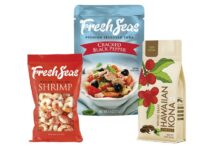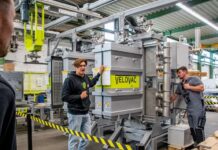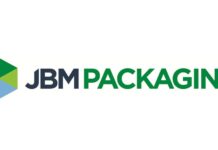By requiring manufacturers to include a minimum percentage of recycled plastic in newly released packaging, the European Commission hopes to lessen the impact of packaging on the environment.
In 2019, only 5% of the plastic used in packaging was made from recycled materials, as reported by the industry group Plastics Europe. The market is dominated by virgin supplies because they are more affordable and of higher quality; hence, recyclers have a difficult time selling secondary resources.
By expanding the recycled content objectives from plastic bottles to all plastic packaging, Brussels is anticipated to increase the demand for recycled plastic in order to combat this. The amendment to the EU’s packaging and packaging waste legislation, which is anticipated on November 30th, will include a proposal in that direction.
By January 2030, according to a leaked draught of the plan obtained by EURACTIV, every plastic package sold in the EU must contain a specific minimal quantity of recycled content collected from post-consumer plastic waste. The tentative targets for 2030, which might alter before the proposal is released, will rise once more by 2040 in the following ways:
- 25% for packaging made of contact-sensitive plastic, such as food wrappers (50% by 2040).
- 50% for single-use beverage bottles made of plastic (and 65% by 2040)
- For other plastic packaging, 45% (and 65% by 2040)
Whatever goals are ultimately set, Brussels’ goal of increasing the market for recycled plastics by requiring a minimum percentage of recycled material in new packaging is obvious. According to the recycling industry group, EuRIC, the move is also anticipated to increase collection rates and encourage businesses to design products that are compatible with the recycling process since doing so is in their best interests.
Eco-design is a requirement if you want to use recycled materials, according to EuRIC Secretary General Emmanuel Katrakis. One needs to collect properly. Recycling must be available. Industries that will purchase recycled materials must exist. Then, it is everyone’s duty to ensure that it operates, he told EURACTIV. The EU’s single use plastics directive currently sets recycled content objectives for plastic bottles manufactured of polyethylene terephthalate (PET), requiring that 25% of bottles contain recycled plastic by 2025 and 30% by 2030.
According to Katrakis, these recycled content targets sparked a paradigm shift in the manufacture and recycling of plastic bottles. According to him, recycling PET reduces energy use and CO2 emissions by more than 70%, and prices now more accurately reflect this.
Producers of plastics in the EU have previously demanded a mandated 30% recycled content objective for the EU by 2030.
However, beverage carton manufacturers argue that the goal should not exceed 30%. Alliance for Beverage Cartons and the Environment’s Annick Carpentier cautions that failure to do so will result in inconsistencies with the single-use plastic regulation. Because they include extra plastic and aluminium layers inside the packaging, beverage cartons present a problem for recyclers. These are included to extend the shelf life of drinks, soups, and sauces as well as to protect the contents from dampness and air.
Although there are methods to separate polymers from the fibre, they haven’t been used much yet, according to the industry, although this is being addressed. According to a study by ACE, the beverage carton sector has already spent around $200 million on recycling infrastructure and has plans to spend an additional €120 million to €150 million through 2027, primarily on facilities for recovering polymers and aluminium. Another option would be to change the packaging’s design to make it simpler to separate the various plastic and paper layers and increase recycling.
According to Mike Turner, managing director of the European Carton Makers Association, eco-design is indeed another extremely key component to enhance recycling rates of items like multi-layered packaging. And that requires building recycling into the package item.
Food-Contact Substances
Making recycled plastic acceptable for use in food packaging presents another issue for recycling plastic.
According to Dorota Napierska, a campaigner for Zero Waste Europe, a thorough revision of the food contact material regulation is required to get rid of dangerous chemicals in virgin materials and guarantee that secondary raw materials are free of toxins in order to permit safe recycled content in food materials. She contends that authorities should place a higher priority on reuse than recycling since doing so may legitimise widespread usage of single-use solutions as long as they are recycled.
As long as they are safe for consumers, ACE claims it is not opposed to recycled content goals for plastic. Carpentier remarked that there are restrictions on the quantity of recycled plastic that can be used in products that come into contact with food. She noted that mandating recycled material for contact-sensitive applications may not be the best choice due to safety concerns.
An anticipated 41% of plastic packaging trash in the EU was recycled in 2019, supporting the need for recycled content objectives to increase recycling. However, EuRIC requests that the European Commission extend these goals for recycled content beyond plastic and apply them to other kinds of materials. Because the benefits accrue regardless of the substance people choose to recycle, it isn’t only a matter of justice, according to Katrakis.
In agreement is Zero Waste Europe’s director. Joan Marc Simon, who opines that recycled content targets have been the most effective motivator for packaging legislation and should be looked into as a tool for other materials, to make sure that closed loop recycling truly occurs, believes that having recycled content targets for other commodities would be very helpful. For instance, aluminium cans are relatively recyclable, yet nations like France lack can-to-can recycling systems. These kinds of situations may be unblocked by a recycled content policy, the speaker said.
Carpentier, however, opposes recycled content goals for products like paper that currently reach high recycling rates. The recycled fibres end up in new products, so they don’t think it would make sense to route these fibres in a closed loop system into the same products, both from an economic and ecological standpoint, she said.
Closed-Loop Recycling Is Waste Paradise
Everyone agrees that waste collection needs to be improved since it will be essential to ensuring that there is enough material available to be recycled into new items. A distinct 90% collection goal for recycling all beverage packaging, whether it is made of metal, glass, or plastic, has been requested by Reloop, a coalition of businesses and environmental NGOs, by the year 2029.
Additionally, it urges member states whose collection performance falls short of the intermediate benchmarks required to reach the 90% target to implement deposit return systems (DRS).
The alliance asserts that when measures are taken to direct the containers again into a closed-loop bottle-to-bottle and can-to-can recycling system, a 90% separate collection objective will assure higher recyclability and recycled content in packaging. Reloop reports that Finland, Germany, Denmark, Lithuania, and Norway, already reached their 90% goal and that deposit return systems will be in place in 18 EU nations by 2026, accounting for 45% of the EU’s population.
The 90% aim would provide huge climate savings and bring the beverages sector into a waste nirvana of closed-loop recycling, according to Reloop, and after some initial pushback, many industry leaders are now openly embracing DRS.



























